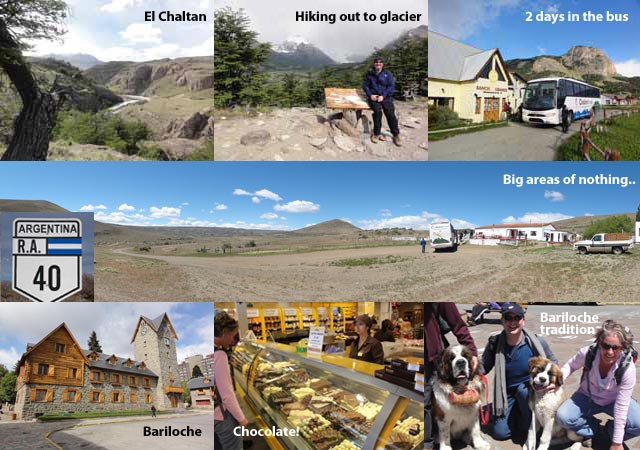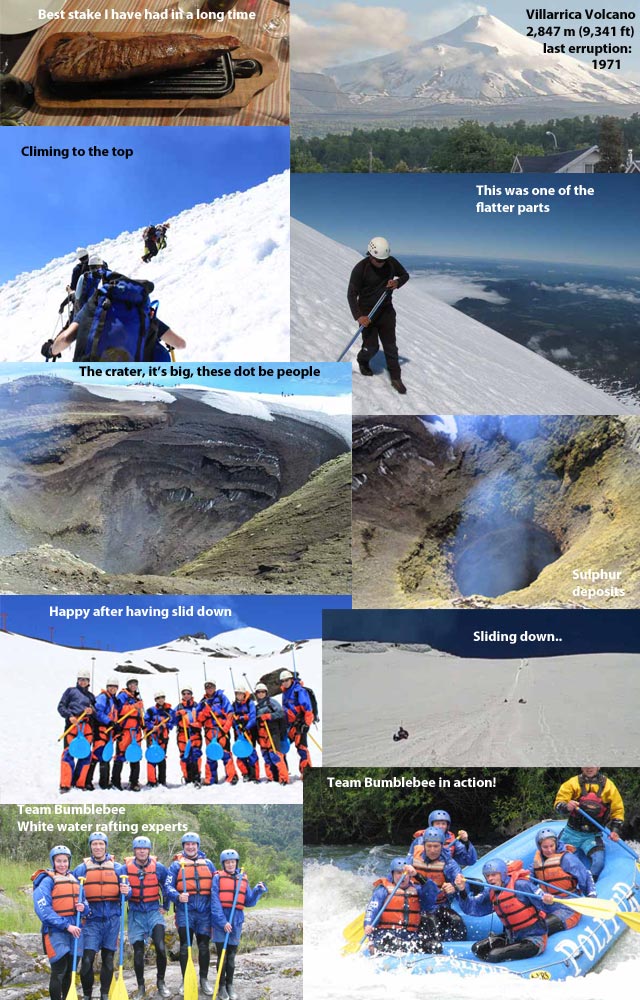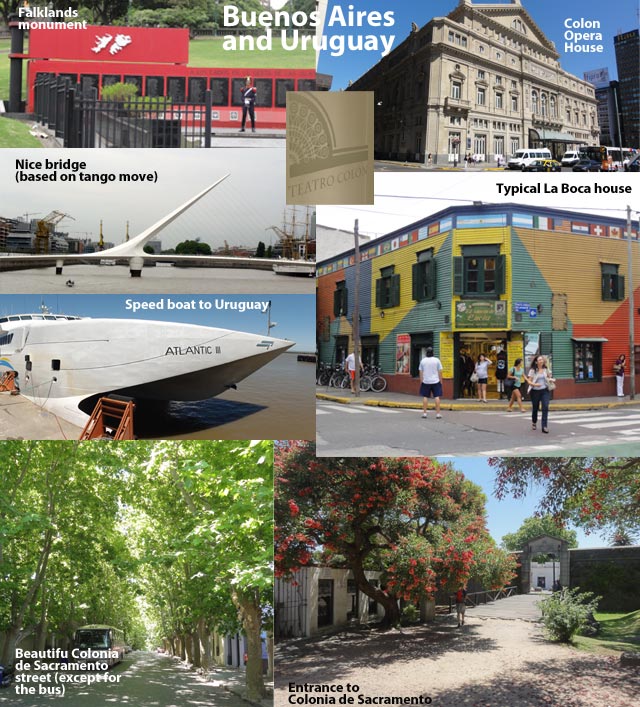Getting to the Thrill – Ushuaia to Bariloche
After the chill of Antarctica, the next part of this South American extravaganza was the thrill of Patagonia. We had pre-booked an 11-day tour and now had 3 days to travel the 1,500 km from Ushuaia to Bariloche, the tour starting point and more importantly Argentina’s chocolate capital. I decided to take some time to see more of the country and after a short flight and a hike in the beautiful (and windy) mountains around El Chalten, took a 2 day bus ride to experience about 1,000kms (about one fifth) of the infamous Route 40.
Ruta 40, as it is known, is not really a road, more like a gravel track that runs parallel to the Andes along the spine of Argentina – it is currently being paved, but it really gives you an insight as to how vast and how empty the country is – 13 people per km², compared to Germany and UK with about 250. Huge expanses of land stretched to the hills and we maneuvered and bumped past llamas and flamingos en-route.
Arriving in Barlioche, we met up with 3 European friends and we fell on the chocolate shops that litter the high street, and I got a terrible hair cut that had to be corrected later in the trip. There we also met up with our guides and the rest of the party, 2 sporty US couples who started chatting about marathons run, epic hikes hiked, and bicycling holidays cycled. We were slightly intimated as we sheepishly tucked in to another mound of chocolate, but over the next 10 days we bonded as they turned out to be most agreeable and we managed to keep up (and sometimes better them) in our sporting exploits.

“Multi-Sport” – Argentina
The 11 day tour was billed as a “multi-sport” (level 3) holiday including hiking, rafting, cycling and something called “non-technical” climbing. After a bit of relaxation around the lake of our superb hotel, we started off by jumping on our bikes and off we went (with our guide). Somehow I showed a penchant for up-hill biking and overtook all, even the guide, but going downhill was a different kettle of fish. However, we all made it with minimal pushing in the gorgeous, mountainous Patagonian countryside.
Cycling alternated with hiking as we trekked for up to 25 km per day through forests and national parks, admiring the mountains, lakes, glaciers, and wildlife. One point we were lucky to emerge on gully where condors majestically swooped and dived on the thermals. These, however, were not my favorite bird – this accolade went to a much smaller example that lived next to one of our hotels, it was called an alarm bird and rightly so. Anytime you got anywhere near it, it shrieked warnings which caused its accompanying chicks to freeze, almost perfectly blending in to the undergrowth, and attacking anything or anyone that came close, as a photographer in our party discovered, much to our chagrin.
The exhaustion felt at the culmination of an excursion was nicely tempered by tables groaning with an assortment of drinks, breads and tasty snacks. Victor, our main guide, was a welcome sight as he cheerfully opened a bottle of wine as we emerged, hot and dusty, from our activities.
After 8 days of “warming up” in perfect weather conditions, we crossed the Argentinean border and stopped for a lovely picnic lunch in a forest of monkey puzzle trees, before experiencing the cavity search and passport-stamping frenzy at the Chilean border. We later found out, lunch had to be served before we reached the Chilean border, as you are not allowed to import anything edible – I not sure the Argentineans like the Chileans very much (and vice versa).

“Multi-Sport” – Chile
Once in Chile we jumped on our bikes to cycle about 35km in to the city of Pucon, where the first night started well, one of the best steak I have probably eaten in my life and more chocolate. At one point I was prompted to make conversation, my response was simply “can’t talk, eating”.
Just near Pucon is the most active volcano in Chile, the Villarrica Volcano, which last erupted in 1971. Here we participated in the most strenuous activity of the trip – the “non-technical” snow covered climb to the crater – 5 kms in length and 1,400 meters elevation gain. Equipped with crampons, ice axe and a plastic mat we started the grueling ascent at about 7:30 am. We had perfect weather, no wind and bright sunshine and we traipsed up and up, over the ice fields and glaciers for what seemed like hours (we actually did it in a relatively fast 3 hours). Reaching the top, I had tears in my eyes, not from the superheated, noxious sulphur gasses, but from relief and joy. Due to the still conditions, these gasses shot up vertically from the main vent meaning we could circumnavigate the entire, massive crater, an uncommon experience our guide informed us as we meditatively chewed down on our packed lunches.
In comparison with the trip up, the descent took less than an hour as we stowed our crampons and got out the plastic mats to literally slide down the side of the volcano. Using the ice axe acting as a break, we barreled down the seemingly almost vertical slopes – brilliant fun. At the bottom, rather a lot of snow had collected under my backpack – removing it, I was accused of pulling a snowman out of my arse – I concurred and am now working on reproducing a scale model of the Titanic, rather than a simple snowman.
But for me, the absolute highlight of the trip was the white water rafting the next day. The class III+ rapids were exhilarating and the competition between our two 6-man inflatables was intense. Our boat, the Bumblebee, was invaded by Victor from his boat, the El Crapo, and he started to forcefully eject people in to the river. He managed to dunk one Bumblebeer, and then advanced towards me but seriously underestimated my obstinacy and, after a bit of a skirmish, ended up himself in the water, with me still sitting pretty. Our skipper was delighted and high-fived me, apparently Victor had not been dunked before. Revenge was short lived though; at the end of the tour, the entire crew of the El Crapo were waiting to get me.. let’s just say, they got me in eventually, but they also suffered a series of knuckle injuries thanks to my trusty paddle as they tried to board.

Buenos Aires
From the joys of Chile, it was back to Buenos Aires, and, flushed with the success of the Patagonia tour, we took a 12 km bike ride round the city to see some of the highlights of “the Paris of the Southern Hemisphere”:
- The first stop, rather insensitively I thought, was the Malvinas (Falkland Islands) Monument which I naturally ignored, pending requested apologies from the Argentinean government.
- La Boca, famed for its multi-coloured houses, a remnant of the original immigrants who used small (non-matching) pots of left-over paint from the harbor to paint their homes. This tradition has morphed in to an art form now and the area is crowded with tourist buses and tango displays.
- The Teatro Colon, the opera house – a beautiful building, whose claim to fame are its world-class acoustics and that it was the biggest in the southern hemisphere, prior to Sydney. Now call me old fashioned, but if I were to name an opera house after a body part, I would probably have chosen something a little more hip, such as “The Elbow” or more suitable “The Cochlear” – but there it is. I mentioned this to the staff and was respectfully informed it was named after Columbus. Who knew?
- The Casa Rosada, the famous pink building with the balcony where Eva Peron sung “Don’t cry for me Argentina” to the crowds – or something like that, my memory is a little vague. It still houses the office of the Argentinian president, who Hilary Clinton thinks should be psychologically tested, according to Wikileaks. This was the top news story during the whole of our stay.
- Plaza de Mayo, a large plaza next to the Casa Rosada and a central starting point for all demonstrations in the capital. Now believe me there are lots of noisy demonstrations in Buenos Aires, so the area was very busy. In fact, they are a little like buses, if you missed the 2:30 demonstration, there was no need to worry as there was typically another one along a few minutes later and sometimes 2 or 3 came along at once.
Uruguay
Our final port of call was a 50 km boat trip away, across the Rio de La Plata or River of Silver, to the World Heritage Site of Colonia de Sacramento in Uruguay. If I thought the number of passport stamps from Argentina to Chile was excessive, entering Uruguay necessitated a positive orgy of stamping, but it was well worth the effort. The day we left it was really hot about 31°c (about 88°f), but Colonia de Sacramento has hundreds of mature sycamore trees lining every street making walking a shady joy.
We ate and drunk and passed many a happy hour perusing the shops and enjoying the laid back atmosphere. We discovered a wonderful bakery that gave us sustenance through the long return stamping process, the boat ride back to Buenos Aires and from there back Germany, where it was colder than Antarctica. Five weeks of being blissed off my chonk, now back to the grindstone and dream of the next Postcard from the Edge.
